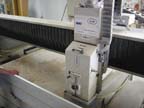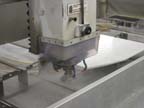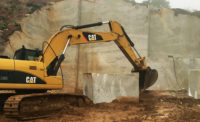
“If you're processing stone for Home Depot, it better be right,†said Thomas L. Beames, president of Wilbedone of Cortland, NY, a 52-employee fabricator that exclusively processes Silestone® quartz countertops for Home Depots in Upstate New York. Wilbedone started out as a Silestone fabricator/distributor for 12 Home Depots, and that total has now grown to 31 locations. As new Home Depots open in the region, Wilbedone will service them as well.
To support the expanding Home Depot business, he keeps his CNC processing equipment and six bridge saws and polishers - all from Marmo Meccanica USA -- running all day long. Wilbedone produces 12 kitchen countertops each day in its 18,000-square-foot building. The company has handled Silestone for Home Depot for more than three years, and business keeps increasing. Beames estimates his business has grown 35% this past year alone.
Although kitchen countertops and islands are the majority of his business - about 80% - Wilbedone also processes Silestone for bathroom vanity tops, table tops, lobby flooring, reception area walls, shower stalls, fireplace surrounds and other residential and commercial applications.
To cut sink holes, odd shapes and complicated edges, two CTEC CNC machines were purchased from Marmo Meccanica USA last year. These were Wilbedone's first CNC machines, and Beames indicated he was interested in adding to his collection in the future.
In learning the technology, Beames explained that the process was simplified through the use of the unit's AutoCAD-lite software. Writing a new program for a sink typically takes about 10 minutes, and running the program is a simple two-step process. “Our operators were never intimidated by the CNC machines,†said Beames. “They found them easy to program and operate, and our operators were running the machines the first week they were here.â€
Beames also said he was impressed with the CTEC 3's 122- x 62-inch worktable space and capabilities, since some of Wilbedone's largest workpieces - measuring 120 x 55 inches - can still be handled on the CNC unit. Although the company's thickest Silestone is only 3 cm, the CNC machine allows machining of full slabs up to 12 1â„2 inches thick.
With all the machines purchased, Beames set about arranging them in a sequential pattern that facilitated a smooth flow through the shop. Sometimes workpieces went from the bridge saw to polisher to the CNC machine, and other times, it was the reverse order. Workpieces typically take just two days to work their way through the shop. Regardless of which machine the Silestone countertop starts on, all the machines are up and running all day long.
“The high uptime, reliability and accuracy of the various machines have provided a quick one-year ROI [return on investment,]†Beames said. “To a small business, a quick ROI is extremely important.â€
In addition to a quick turnaround time, another advantage the company offers to Home Depot customers is a large number of edge treatments. For kitchen counters, the most popular edge is roundover because there is no “up charge.†Other popular edge options include bullnose, demi-bullnose, ogee, bevel and very complicated edges such as the ogee bullnose.
For edge shaping and polishing, Wilbedone shapes and polishes edges in one pass on the Marmo Meccanica USA LTH 721 automatic horizontal polisher, including the complex, multi-step bullnose. Beames purchased this machine about three years ago and said it handles straight edging and polishing of all sizes - from 2 to 10 cm - at 120 lineal feet per hour. Two diamond cupwheels help speed processing.
A year later, Wilbedone purchased Marmo Meccanica USA's LCV 711M flat edge polishing machine with a smaller footprint to handle all the backsplashes. It provides continuous production and one pass polishing, but also chamfers upper and lower edges automatically.
The success of the polisher and flat edge polishing machines led to the purchase of Marmo Meccanica's powerful HTO-1B bridge saw later that year to cut countertops for subsequent processing. Beames reports the bridge saw was easy to learn and has proved to be highly productive. The HTO-1B features a 20-horsepower motor and can cut approximately 120 lineal feet of 3-cm material per hour. It also has a head that can tilt 90 degrees and a hydraulic tilting table.
Because of the growing demand, a second bridge saw was purchased, the HTO-1/0. This saw has three settings to perform cutting functions: manual, auto simple and multiple simple, providing versatility for operators.
In choosing his equipment, Beames cited strong customer service from Marmo Meccanica USA for service, training and parts. “Their service technicians are knowledgeable and helpful,†he said. “I have received excellent assistance over the phone and, if necessary, they'll make a service call within 24 hours.†If repair parts are required, he calls Delta Diamond Tools, Marmo Meccanica USA's tooling supply company that supports fabricating facilities in North America.
A year later, Wilbedone purchased Marmo Meccanica USA's LCV 711M flat edge polishing machine with a smaller footprint to handle all the backsplashes. It provides continuous production and one pass polishing, but also chamfers upper and lower edges automatically.
The success of the polisher and flat edge polishing machines led to the purchase of Marmo Meccanica's powerful HTO-1B bridge saw later that year to cut countertops for subsequent processing. Beames reports the bridge saw was easy to learn and has proved to be highly productive. The HTO-1B features a 20-horsepower motor and can cut approximately 120 lineal feet of 3-cm material per hour. It also has a head that can tilt 90 degrees and a hydraulic tilting table.
Because of the growing demand, a second bridge saw was purchased, the HTO-1/0. This saw has three settings to perform cutting functions: manual, auto simple and multiple simple, providing versatility for operators.
In choosing his equipment, Beames cited strong customer service from Marmo Meccanica USA for service, training and parts. “Their service technicians are knowledgeable and helpful,†he said. “I have received excellent assistance over the phone and, if necessary, they'll make a service call within 24 hours.†If repair parts are required, he calls Delta Diamond Tools, Marmo Meccanica USA's tooling supply company that supports fabricating facilities in North America.
Beames also said that effective training has resulted in high machine productivity from the beginning. “In addition to installing the equipment, they spent a couple days with our operators and management staff explaining the CNC, programming, maintenance and machine operation; basically everything,†said Beames. “They go over the digitizing for the computer and how to lay it out, and get the disk ready so the operator can take it to the CNC and run the job. The training is very complete.â€
In order to ensure a consistent rate of production, workers in Wilbedone's shop learn how to operate multiple machines. “To maximize machine uptime, we cross train our operators,†he said. “So even though we have one operator dedicated to one machine, the bridge saw operator can operate the CNC machines, and the CNC machine operator can run the polishing machines and so on.â€
As a result of these various factors, Wilbedone experienced its best year ever in 2004. To handle real and anticipated business increases, the company purchased another CTEC CNC 3 in November of last year, and it also invested in the first CTEC waterjet sold in North America. The new computerized waterjet was purchased to cut and shape countertops and backsplashes in one setup, eliminating the need for primary cutting on a bridge saw combined with secondary operations.
In January of next year, the company is scheduled to add a second shift to handle continually expanding business. “It's important to keep customers happy in any business,†Beames said. “But when your customer is Home Depot - with a sophisticated customer base that demands nothing less than perfect - you have to have the absolute best equipment and trained personnel to deliver the highest quality countertops, sinks and islands time after time.â€

Sidebar
Practical operation of the CNC stoneworking center
CNC machines are becoming popular because they are capable of machining extremely complicated designs fast and accurately. An example of this can be found in the fabrication of a kitchen countertop in the “butterfly†style, a common operation at Wilbedone using the Marmo Meccanica CTEC 3.
Using a traditional bridge saw, polishing machine and/or jig saw, this can be a time-consuming operation. With CNC technology, the time and labor needed is minimized. First, the butterfly-shaped countertop is drawn to actual size. Then the operator digitizes the butterfly shape. To do this, he uses a digitizer (such as one with an infrared light) to follow the shape of the butterfly. He “clicks†at various points along the periphery and then tells the computer to literally “connect the dots,†which it does to make a perfect butterfly pattern. The digitized butterfly shape can now be viewed on the computer screen.
Then the operator programs the machining operation, which typically goes as follows: Step 1: Cut a specific shape with a particular bit. Step 2: Make a bullnose (or other) edge. Step 3: Go around the perimeter with #1 polishing head, and so on. The operator installs the proper tools and he pushes the “Start†button.
The tool lowers to the slab and begins an automatic cutting process that does not stop until it has gone around the entire periphery, cutting the desired shape. If the unit has an automatic tool changer, it will find the selected polishing head and resume operations until it has the desired edge and polish. Otherwise, the operator replaces the heads, and the operation resumes. About seven different tools are required from start to finish. Upon completion, a perfectly shaped butterfly pattern has been machined quickly and accurately.
Larger shops like Wilbedone, Inc. often have two CNC machines. An operator working at a shop with two CNC machines will be busy all day digitizing, programming, changing tools, and swapping old jobs for new ones - all to maximum efficiency in terms of time and labor.

